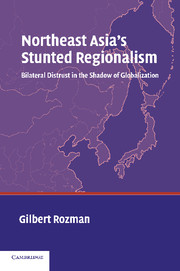Book contents
- Frontmatter
- Contents
- Acknowledgments
- Map
- Northeast Asia's Stunted Regionalism
- 1 Introduction: The Challenge of the Northeast Asia Region
- 2 Exiting the 1980s: Cold War Logic and National Aspirations
- 3 1991–1993: Border Fever and Cross-Border Duplicity
- 4 1994–1996: Civilizational Bridges and Historical Distrust
- 5 1997–1998: Strategic Partnerships and National Rivalries
- 6 1999–2000: Sunshine Policy and Security Dilemmas
- 7 2001–2003: Unilateralism and Irrepressible Regionalism
- 8 Conclusion: Lessons for Constructing Regionalism in Northeast Asia
- Index
2 - Exiting the 1980s: Cold War Logic and National Aspirations
Published online by Cambridge University Press: 18 December 2009
- Frontmatter
- Contents
- Acknowledgments
- Map
- Northeast Asia's Stunted Regionalism
- 1 Introduction: The Challenge of the Northeast Asia Region
- 2 Exiting the 1980s: Cold War Logic and National Aspirations
- 3 1991–1993: Border Fever and Cross-Border Duplicity
- 4 1994–1996: Civilizational Bridges and Historical Distrust
- 5 1997–1998: Strategic Partnerships and National Rivalries
- 6 1999–2000: Sunshine Policy and Security Dilemmas
- 7 2001–2003: Unilateralism and Irrepressible Regionalism
- 8 Conclusion: Lessons for Constructing Regionalism in Northeast Asia
- Index
Summary
If we consider the first stage of regionalism in NEA to be the period from the spring of 1989 to the beginning of 1991 – bracketed by the dramatic events in Beijing and the Persian Gulf War – then we should begin our story even earlier when the states that intersect in NEA were redefining their objectives while the cold war was still in progress. Long before anyone predicted that the 1990s would be free of the shadow of the Soviet-American conflict, important new currents were present. These, in turn, shaped rising hopes from 1987 and then the scrambling for a fresh start from 1989. First came national rethinking, then anticipation of regionalism, and finally a rush to seize new opportunities.
The goal of establishing an NEA region was taken seriously from the second half of the 1980s. Mikhail Gorbachev played a leading role, calling in 1986 for the integration of Russia into the Asia-Pacific region. Japanese analysts seized this opportunity, appealing for a narrow regionalism centered around the rim of the Sea of Japan, at the same time offering a vision of how a breakthrough in bilateral relations with Moscow could lead to great-power ties linked to regionalism. From 1990 China stood in the forefront in institutionalizing the discussion through research centers and journals devoted to NEA regionalism, a notion intermediate between Russia's broad concept and Japan's narrow one.
- Type
- Chapter
- Information
- Northeast Asia's Stunted RegionalismBilateral Distrust in the Shadow of Globalization, pp. 21 - 71Publisher: Cambridge University PressPrint publication year: 2004



